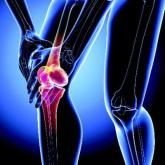Weakness in the lower thigh muscles is a stronger risk factor for knee osteoarthritis in women than in men, possibly because of the greater influence that high body mass index has on thigh muscle strength in women, according to new case-control study findings.
The findings, published online Feb. 8 in Arthritis Care & Research (doi: 10.1002/acr.23182), come from a study enrolling 161 patients with radiographic knee osteoarthritis and 186 controls without arthritis at baseline who were observed over a 4-year period in the ongoing multicenter Osteoarthritis Initiative cohort study. About 60% of patients and controls were women.
The researchers, led by Adam Culvenor, PhD, of Paracelsus Medical University in Salzburg, Austria, used axial MRI scans of anatomical cross-section areas of the knee flexors (hamstrings) and extensors (quadriceps) to calculate muscle-specific strength, a measure of muscle quality.They found that lower muscle-specific strength in these areas significantly increased the risk of incident knee osteoarthritis in women, with odds ratios of 1.47 (95% confidence interval, 1.10-1.96) for knee flexors and 1.41 (95% CI, 1.06-1.89) for extensors. This relationship was not significant in men, and in women, the relationship lost statistical significance after adjustment for high body mass index (BMI). Lower specific strength was associated with higher BMI in women (r = –0.29, P less than .001), but not in men.
“The lower muscle-specific strength in the presence of higher BMI in women (possibly driven by greater intramuscular adiposity), but not in men, may provide a possible explanation” for the differences in knee osteoarthritis incidence in men and women with muscle strength deficits, Dr. Culvenor and colleagues wrote in their analysis.
“The response of thigh muscle to variations in BMI differed between men and women, with apparently more contractile tissue (and strength) being present in men with greater BMI, and apparently more noncontractile (adipose) tissue in women with greater BMI,” the researchers concluded.
The Osteoarthritis Initiative is cofunded by the National Institutes of Health and a consortium of pharmacological manufacturers. The work for this analysis also received funding from Paracelsus Medical University and the European Union Seventh Framework Programme. Three of the study’s seven coauthors disclosed extensive financial relationships, including employment, with Chondrometrics GmbH, a company that provides MRI analysis services, among other firms, while four disclosed no commercial conflicts.
